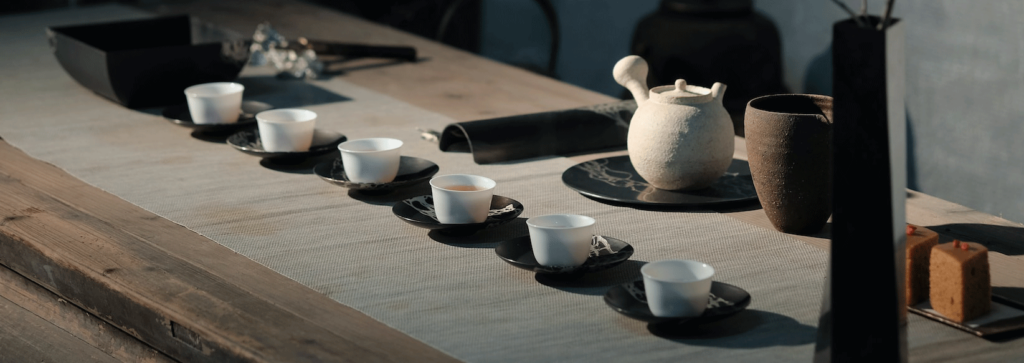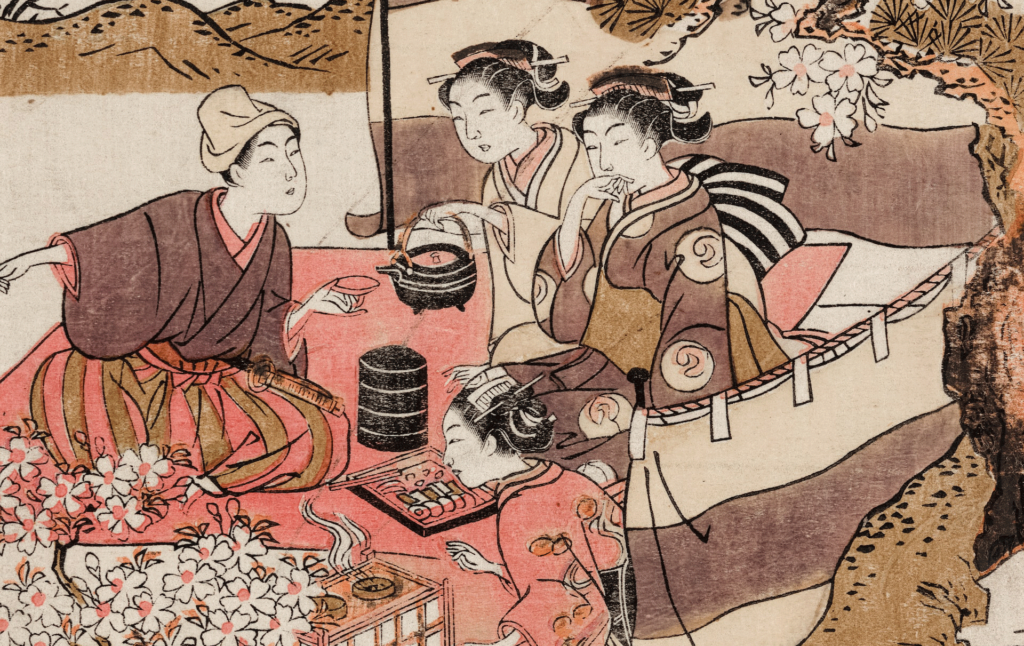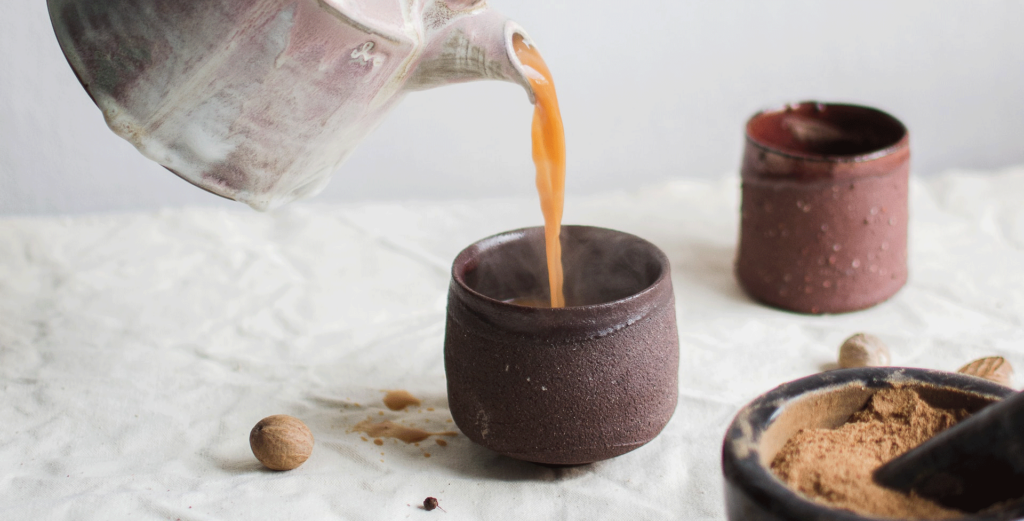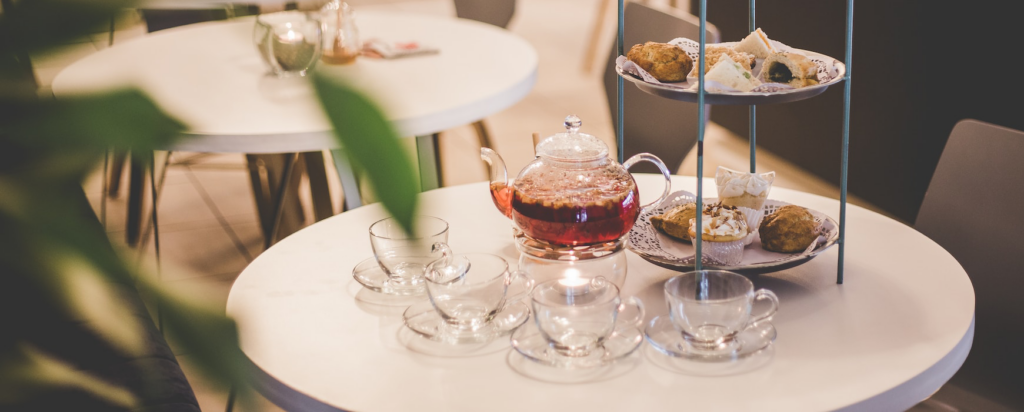Table of Contents
Introduction
Imagine stepping into a world where each sip of tea tells a tale of tradition, ceremony, and community. This is the realm of Tea Culture, a term that resonates with the very heartbeats of civilizations across centuries. As we embark on this fascinating journey, we’ll immerse ourselves in the myriad ways tea has been woven into the daily lives and special occasions of cultures worldwide.
Tea Culture is more than a beverage preference; it’s an emblem of shared experiences. Picture a serene Japanese tea ceremony, where every gesture embodies respect and mindfulness. Think of the cozy British teatime, complete with scones and cucumber sandwiches, a cherished social tradition. These are just glimpses of the enchanting world we’ll explore, where tea has been a catalyst for connection, reflection, and celebration.
Enchanting Origins of Tea: Where Leaves and Legends Intertwine
To truly fathom the magic of Tea Culture, we must embark on an exhilarating voyage into the distant past. Our quest begins at the very birthplace of tea culture, where the verdant landscapes of ancient China cradle the origins of this treasured elixir. It’s a tale that spans millennia, where tea leaves journey from wilderness to worldwide adoration.
In Search of the Tea’s Birthplace: Tracing the Origins of Tea Culture
Venture deep into the heart of China’s history, where myths entwine with reality. Over 4,000 years ago, Emperor Shen Nong’s serendipitous encounter with tea leaves forever changed the course of human culture. As the first tea leaves danced into a pot of boiling water, the world witnessed the birth of a tradition that would shape dynasties and transcend continents.
Tea Culture Chronicles: Moments and Makers of Tea’s Epochal Journey
In the annals of tea history, certain moments and luminaries shine like stars in the night sky. Chinese sage Laozi extolled the virtues of tea, while Tang Dynasty tea master Lu Yu penned the “Classic of Tea,” setting the stage for tea appreciation. The journey didn’t stop there; tea ventured to Japan, evolving into the revered Japanese tea ceremony.
Sip by Sip: Tea’s Timeless Influence on Global Civilizations
Tea leaves, like nomads of old, journeyed far and wide, leaving their mark on diverse civilizations. India embraced tea, weaving it into the fabric of daily life and social gatherings. In England, the iconic afternoon tea ritual unfolded with grace and elegance. Russian samovars brewed tales of strong black tea, while Moroccan mint tea became a symbol of North African hospitality.
In this historical odyssey, we’ll uncover the mesmerizing tapestry of Tea Culture, where each thread is a unique tradition or practice woven into the grand narrative of this remarkable beverage. Join us as we embark on a journey that unfurls the leaves of time, revealing the enchanting origins of tea culture that have transcended boundaries and endured through centuries.
Global Tea Traditions: A World of Sip-Worthy Stories
In our quest to understand the intricate tapestry of Tea Culture, we embark on a journey that transcends geographical boundaries, revealing the rich and diverse traditions that tea has fostered across the globe. Beyond being a mere beverage, tea serves as a cultural bridge, a symbol of hospitality, and a testament to the heritage and values of different societies. In this chapter, we’ll take a closer look at some of the world’s most prominent tea cultures, explore their unique customs, and delve into the rituals that have been perfected over centuries.
Navigating the World of Tea: Exploring Key Culture Traditions
Our expedition begins with a global tour of tea cultures, highlighting the significance of tea beyond its flavor and aroma. Japan beckons with its meticulously choreographed tea ceremonies, where every gesture embodies respect and mindfulness. In India, we’ll uncover the vivacious chai culture, a bustling fusion of flavors and camaraderie. Sri Lanka’s tea gardens, Tibet’s nomadic traditions, and the tea houses of Turkey all contribute to the diverse tapestry of Tea Culture. These are not merely customs; they are profound expressions of cultural identity.
Tea Ceremonies and Beyond: Unveiling Unique Customs and Rituals
Within each tea culture, we find a treasure trove of customs and rituals that have stood the test of time. In China, the elegance of a traditional tea ceremony unfolds, where the pouring of tea becomes a ballet of grace and precision. In Morocco, brewing mint tea becomes a symbol of generosity and hospitality, as well as a cherished tradition. These rituals are not just about making tea; they are about creating moments of connection, reflection, and meaning.
Sip and Savor: Embracing Key Culture Traditions Worldwide
As we sip and savor the various tea traditions, we gain deeper insights into the heart and soul of each culture. Tea transcends language and borders, fostering connections that go beyond the tea leaves in the cup. It’s in the warmth of a cup shared among friends, the laughter around a tea table, and the bonds formed through centuries of tea-drinking. Each tradition is a testament to the enduring power of tea to bring people together and celebrate the essence of humanity.
Join us as we embark on this enlightening journey to explore the intricate tapestry of global tea cultures. Through each tradition, we’ll discover how Tea Culture is not just a reflection of flavor but a profound expression of cultural diversity, creativity, and the universal desire for connection and meaning.
Traditional Chinese Tea Culture: A Glimpse into Centuries of Elegance

Our exploration of Tea Culture brings us to the heart of China, where tea has been an integral part of history, culture, and daily life for millennia. In this chapter, we will delve into the profound influence of tea on Chinese civilization, uncover the intricate art of the Gongfu tea ceremony, and unravel the symbolism that tea holds in the tapestry of Chinese culture. For more information about Chinese tea culture click.
Importance of Tea in Chinese History: From Myth to Monarchy
To understand the significance of tea in China, we must journey back to its very beginnings. Here, tea isn’t just a beverage; it’s a cornerstone of history. Legend has it that Emperor Shen Nong, the mythical father of Chinese medicine, discovered tea when tea leaves accidentally fell into his pot of boiling water. This serendipitous encounter marked the genesis of a cultural revolution. Tea became a staple in Chinese society, evolving from a medicinal brew to an art form, and ultimately, a symbol of hospitality.
Gongfu Tea Ceremony and Its Intricacies: The Dance of Precision
Step into the world of Gongfu tea, a ceremony that epitomizes grace, mindfulness, and precision. Every aspect of this traditional Chinese tea ceremony is meticulously choreographed. From the selection of teapot to the pouring technique, each movement reflects a deep respect for the tea, the host, and the guest. We’ll explore the intricate details of Gongfu tea, where timing, temperature, and tradition merge to create a moment of pure elegance.
Symbolism of Tea in Chinese Culture: Harmony, Respect, and Tradition
In Chinese culture, tea goes beyond its flavor and aroma; it is laden with symbolism. The act of sharing tea represents harmony, respect, and connection. The art of pouring tea for elders or guests is a gesture of filial piety and respect. The humble tea leaf itself is a symbol of endurance and transformation, mirroring the resilience of the Chinese people through centuries of change.
Japanese Tea Culture: Where Harmony, Zen, and Matcha Unite

Our journey through the world of Tea Culture now transports us to the serene landscapes of Japan, where tea takes on a profound and meditative significance. In this chapter, we’ll delve into the art of Japanese tea ceremonies, explore the profound influence of Zen Buddhism on these rituals, and discover the pivotal role that matcha plays in Japanese society. For more information about Japanesetea culture click.
Art of Japanese Tea Ceremonies (Chanoyu): A Dance of Grace and Ritual
Central to Japanese tea culture is the art of the tea ceremony, known as Chanoyu. It’s a captivating dance of grace and ritual where every movement, from the way tea is prepared to the arrangement of utensils, embodies harmony, respect, purity, and tranquility. We’ll journey through the intricate choreography of Chanoyu, where the host’s every gesture is an expression of mindfulness, and the guest’s every sip is an act of appreciation.
Zen Buddhism’s Influence on Japanese Tea Culture: A Path to Enlightenment
To truly understand the essence of Japanese tea culture, we must delve into the profound influence of Zen Buddhism. Zen philosophy’s core principles of mindfulness, simplicity, and living in the present moment are beautifully encapsulated in the tea ceremony. We’ll explore how Zen Buddhism and tea culture became intertwined, creating a path to enlightenment that transcends the boundaries of the tearoom.
Role of Matcha in Japanese Society: More Than Just a Green Beverage
Matcha, a finely powdered green tea, is the beating heart of Japanese tea culture. It’s not just a drink; it’s a symbol of unity and shared experiences. From traditional tea ceremonies to contemporary matcha cafes, we’ll uncover how matcha weaves its way into the fabric of Japanese society. With its vibrant green hue and unique umami flavor, matcha is not only a beverage but a cultural icon.
Indian Chai Culture: A Spicy, Sweet Symphony of Flavor and Community

In our expedition through Tea Culture, we find ourselves in the vibrant land of India, where chai, a beloved brew, is more than just a beverage; it’s a cultural phenomenon. In this chapter, we’ll dive into the cultural significance of chai in India, explore the art of preparing and savoring masala chai, and uncover the heartwarming social aspect of chai culture. For more information about Indian tea culture click.
Cultural Importance of Chai in India: A Ritual, a Tradition, a Way of Life
Chai runs through the veins of India, touching every corner and every heart. Its cultural importance is unparalleled, transcending socio-economic divides. From bustling cities to remote villages, chai is a unifying thread that weaves the fabric of Indian society. We’ll journey through the origins of chai in India, where it evolved from Ayurvedic traditions to become an inseparable part of daily life.
Preparing and Enjoying Masala Chai: The Alchemy of Spices and Tea Leaves
At the heart of Indian chai culture lies masala chai, a fragrant blend of spices and tea leaves. We’ll step into the aromatic world of chai preparation, where each ingredient is carefully selected and combined to create a symphony of flavors. From cinnamon and cardamom to ginger and cloves, we’ll uncover the alchemy that transforms a simple cup of tea into a sensory delight.
Tea Stalls and the Social Aspect of Chai Culture: Where Strangers Become Friends
In India, chai is not just a solitary ritual; it’s a social glue that binds communities. At bustling tea stalls and roadside dhabas, strangers become friends over cups of chai. We’ll explore the communal spirit of chai culture, where chaiwallas (tea vendors) are often the storytellers and listeners of neighborhoods. It’s a culture where conversations flow as freely as the tea, fostering connections and camaraderie.
British Afternoon Tea Culture: A Tale of Elegance, Etiquette, and Delights

Our exploration of Tea Culture now transports us to the charming traditions of British afternoon tea, a quintessential part of British heritage that has graced drawing rooms and tearooms for centuries. In this chapter, we’ll uncover the origins of British afternoon tea, delve into the etiquette that surrounds teatime, and savor the iconic customs and delectable foods that make this culture unique. For more information about British tea culture click.
Emergence of British Afternoon Tea Traditions: From Duchess to Delight
The story of British afternoon tea dates back to the early 19th century when Anna, the Duchess of Bedford, found herself longing for sustenance between lunch and dinner. Her ingenious solution was to introduce a mid-afternoon tea and light snacks. This simple act gave birth to a tradition that soon swept across England. We’ll journey through the historical origins of afternoon tea and explore how it evolved into an emblematic British ritual.
Tea Etiquette and the Significance of Teatime: Sipping with Grace
Tea etiquette is at the heart of British afternoon tea culture. From the proper way to hold a teacup to the intricacies of pouring milk before or after tea, these customs have been passed down through generations. We’ll immerse ourselves in the art of sipping with grace and unravel the significance of teatime as a moment of refinement and social connection.
Iconic Tea-Related Customs and Foods: Scones, Cucumber Sandwiches, and More
No exploration of British tea culture would be complete without savoring the iconic customs and foods that accompany it. From freshly baked scones adorned with clotted cream and jam to delicate cucumber sandwiches, we’ll indulge in a feast of flavors and traditions. We’ll also explore the art of pastry-making and discover how tea has inspired a myriad of delectable treats, from Victoria sponge cake to buttery shortbread.
Modern Tea Trends: Steeping into the Digital Age, Wellness, and Culinary Creativity
As we continue our exploration of Tea Culture, we find ourselves at the crossroads of modernity, where age-old traditions intersect with contemporary lifestyles. In this chapter, we’ll trace the evolution of tea culture in the digital age, sip on the wellness trends that are brewing, and savor the fusion of tea with a myriad of culinary delights.
Evolution of Tea Culture in the Digital Age: Sipping and Sharing in Cyberspace
The digital age has ushered in a new era of tea culture, where tea enthusiasts from around the world connect, share, and explore the vast world of tea online. We’ll delve into the virtual tea communities, where tea bloggers, vloggers, and social media influencers are redefining how we perceive, prepare, and appreciate tea. From virtual tea tastings to tea-themed podcasts, the online world has become a teapot filled with endless possibilities.
Tea and Wellness Trends: Brewing for the Body, Mind, and Spirit
Wellness has taken center stage in modern tea culture. Beyond flavor and aroma, tea is now celebrated for its potential health benefits. We’ll explore the burgeoning trends of herbal infusions, detox teas, and mindfulness through tea. Discover how tea has become a daily ritual for those seeking balance, tranquility, and a moment of respite in a fast-paced world.
Fusion of Tea with Other Culinary Delights: A Feast for the Senses
Modern tea culture isn’t confined to a teacup; it extends its influence to the culinary world. From tea-infused cocktails and mocktails to tea-flavored desserts and savory dishes, we’ll savor the creative fusion of tea with a myriad of culinary delights. It’s a realm where tea becomes an ingredient in the chef’s palette, adding depth and complexity to gastronomic experiences.
Tea Artistry and Crafts: Where Beauty, Tradition, and Imagination Converge
Our journey through Tea Culture now leads us to the enchanting world of tea artistry and crafts, where beauty is not just in the cup but in the very essence of creation. In this chapter, we’ll immerse ourselves in the captivating artistry and craftsmanship that adorn the world of tea. From exquisite teapots to delicate porcelain, we’ll explore the key elements that elevate the tea experience.
Beauty of Tea-Related Art and Craftsmanship: Where Tea Becomes an Art Form
Tea is more than just a beverage; it’s a canvas for artistic expression. We’ll marvel at the intricate details of tea-related art and craftsmanship, where every piece is a work of art. From hand-painted teapots to meticulously carved tea trays, we’ll witness how tea transcends utility to become a medium for creative expression. It’s a realm where artists and artisans breathe life into the teapot, the teacup, and every tea-related accessory.
Tea-Related Art Forms, Pottery, and Utensils: Masterpieces of Precision
Tea culture has nurtured an array of art forms, pottery styles, and utensils that are as diverse as the teas themselves. We’ll explore the art of Yixing pottery, famous for its unglazed clay teapots that enhance the tea’s flavor over time. We’ll uncover the delicate beauty of Japanese porcelain, where form and function merge seamlessly. From the handcrafted bamboo whisks used in matcha preparation to the graceful curves of gaiwan, we’ll celebrate the masterpieces of precision that grace the world of tea.
Key Elements of Tea Culture: Where Beauty and Tradition Flourish
In the intricate patterns of a teacup’s glaze or the fine lines of a calligraphy-decorated tea scoop, we find the soul of tea culture. These elements not only elevate the tea-drinking experience but also connect us to traditions that have withstood the test of time. As we delve into the realm of tea artistry and crafts, we’ll discover how these key elements breathe life into the world of tea, enriching our senses and connecting us to the rich tapestry of history and culture.
Preserving and Celebrating Tea Culture: Guardians of Tradition and Global Festivities
As our odyssey through Tea Culture nears its conclusion, we turn our attention to the preservation and celebration of this cherished heritage. In this final chapter, we’ll delve into the dedicated efforts to safeguard traditional tea practices, immerse ourselves in the vibrant tapestry of international tea festivals and events, and explore the ways in which we can encourage the appreciation of tea culture for generations to come.
Efforts to Safeguard Traditional Tea Practices: Guardians of the Past
Across the world, passionate individuals and organizations stand as guardians of traditional tea practices. We’ll meet the artisans and tea masters who are passing down ancient techniques, ensuring that the art of tea lives on. From the terraced fields of Darjeeling to the tea houses of Kyoto, these dedicated stewards of tradition labor to preserve the authenticity and cultural richness of tea.
International Tea Festivals and Events: A Global Celebration of Tea
Tea culture knows no borders, and the world comes together to celebrate it through international tea festivals and events. We’ll journey through these vibrant gatherings, from the World Tea Expo in Las Vegas to China’s annual International Tea Culture Expo. These festivals provide a platform for tea enthusiasts, experts, and newcomers to share in the joy of tea, learn from one another, and forge connections that span continents.
Encouraging the Appreciation of Tea Culture: Sowing the Seeds of Tradition
The continuation of tea culture relies on nurturing the appreciation of tea in younger generations. We’ll explore initiatives aimed at educating and inspiring youth about the beauty and significance of tea. From school programs that teach the art of tea to community events that introduce the rituals of tea to newcomers, these efforts ensure that the legacy of tea culture remains vibrant and thriving.
Q&A Section: Navigating the Intricacies of Tea Culture
In this final segment of our journey through Tea Culture, we’ll pause to address some common questions that often arise when delving into the world of tea and its diverse cultural tapestry. Let’s explore the nuances and curiosities that make tea culture a fascinating and ever-evolving realm.
- How do different cultures view tea differently? Tea is a chameleon that takes on unique colors in every culture it touches. From the meditative rituals of Japanese tea ceremonies to the robust flavors of Indian chai, each culture brings its own perspective to tea. The reverence, traditions, and customs associated with tea can vary greatly, reflecting the values and history of each society.
- Are there any modern innovations in tea culture? Absolutely! The world of tea culture is not bound by tradition alone. Innovations such as tea-infused cocktails, cold-brew teas, and sustainable tea practices are reshaping the way we experience tea today. Modern tea enthusiasts are constantly exploring creative ways to incorporate tea into their lifestyles, from tea-based skincare to culinary experiments.
- What’s the best way to experience different tea cultures? The best way to immerse yourself in the richness of tea culture is through exploration and appreciation. Traveling to regions renowned for their tea, attending international tea festivals, and participating in local tea ceremonies are fantastic ways to gain insight into diverse tea cultures. Additionally, connecting with fellow tea enthusiasts, whether in person or through online communities, provides a window into the global tapestry of tea traditions.
In our pursuit of knowledge and appreciation, we encounter these questions as stepping stones to a deeper understanding of the intricate world of Tea Culture. With each sip, each conversation, and each exploration, we unlock new layers of richness and connection in the timeless journey of tea.
Conclusion: Savoring the Mosaic of Tea Culture
As we conclude our delightful expedition through the world of Tea Culture, let us linger a moment to savor the intricate mosaic of traditions, flavors, and stories that we’ve encountered. This journey has unveiled a tapestry of diverse tea cultures that transcend time and place, weaving a narrative that transcends borders.
Our voyage has revealed that tea culture is more than a beverage; it’s an embodiment of human connection and shared moments. From the serene tea ceremonies of Japan to the lively chai stalls of India, each cup carries a piece of history, a slice of culture, and a sip of togetherness.
In our exploration, we’ve celebrated the kaleidoscope of tea customs worldwide. The cultural diversity within tea culture is not just a feature; it’s the essence that makes tea so remarkable. It reminds us that in our differences lies our strength, and in our traditions lies our uniqueness.
As we bid adieu to this journey, the doors to tea culture remain wide open, beckoning all to partake in its wonders. Whether you’re a seasoned tea enthusiast or a curious novice, the beauty of tea culture is that it welcomes everyone. Take your own path, brew your own stories, and celebrate the magic of tea in your own unique way.
In this concluding chapter, let us raise our teacups to the rich mosaic of Tea Culture. It’s a culture that binds us together, celebrates our differences, and reminds us that the world is, indeed, a teacup waiting to be filled with experiences, flavors, and moments of connection. Cheers to the past, the present, and the endless possibilities of tea culture.
Related Articles
How To Make Loose Leaf Tea: A Comprehensive Guide
Exploring Turkish Tea Culture: A Journey Through Tradition and Flavor
Exploring Korean Tea Culture: Traditions, Tranquility, and Taste

